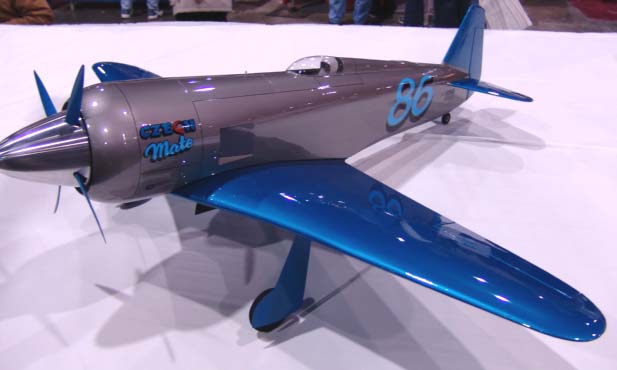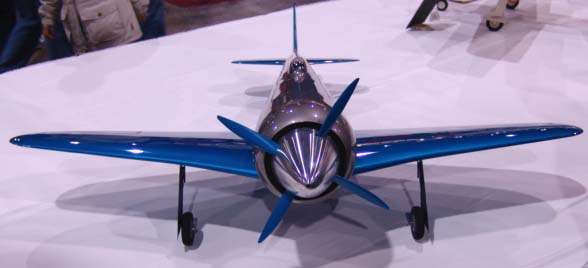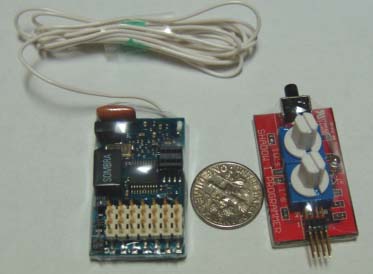 |
Flying High With Electric Power!
The Ampeer ON-LINE!
Fly the Future - Fly Electric! |
Site Table of Contents
| President: | Vice-President: | Secretary/Treasurer: |
| Ken Myers | Richard Utkan | Rick Sawicki |
| 5256 Wildcat | 240 Cabinet | 5089 Ledgewood Ct. W. |
| Croswell, MI 48422 | Milford, MI 48381 | Commerce Twp., MI 48382 |
| (810) 679-3238 | (248) 685-1705 | 248.685.7056 |
 | ||
| Board of Directors: | Board of Directors: | Ampeer Editor |
| David Stacer | Jack Lemon | Ken Myers |
| 16575 Brookland Blvd. | 8908 Sandy Ridge Dr. | 5256 Wildcat Rd. |
| Northville, MI 48167 | White Lake, MI 48386 | Croswell, MI 48422 |
| 248.924.2324 | 248.698.4683 | 810.679.3238 |
| Mailed Ampeer subscriptions are $10 a year US & Canada and $17 a year world wide. FREE on-line! | ||
| The Next Meeting: Date: Saturday, May 7 Time: 10:00 a.m. Place Midwest RC Society 5 Mi. Rd Field | ||
|
By Ken Myers I recently saw these words in the March 2005 Model Aviation magazine. p.103 AMMO ad
p.64 DPM ad
p.34 photo center photo caption
Upcoming Coldwater, MI E-vent You are invited to attend the...
June 4 & 5, 2005
|
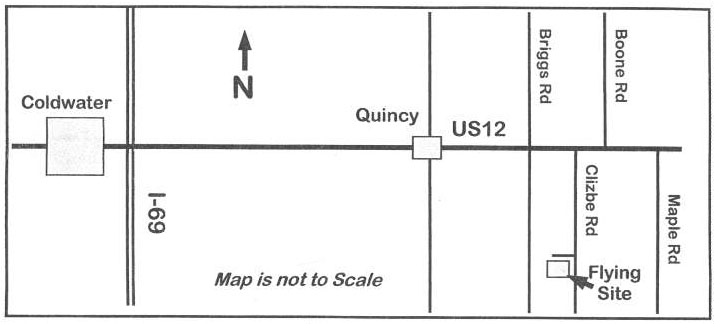
grifesd@yahoo.com or Phone: 517.279.8445 Please e-mail or call with any questions The Flying Field will be open Friday, June 3 for early arrivals Saturday, June 4, hours are from 9 a.m. 'til 5 p.m. Sunday, June 5, hours are form 9 a.m. 'til 3 p.m. Landing Fee is $10 for the weekend. Directions: Quincy is approximately 4.5 miles east of I-69. Clizbe Road is approximately 1.6 miles east of Quincy. The Flying site is approximately 1.5 miles south of US-12 on the west side of Clizbe Road. Places to Stay:
All except Econo-Lodge are located near I-69 & US-12. Econo-Lodge is on the west side of Coldwater. The March EFO Meeting Once again Rick Sawicki hosted the March meeting at his house. It was a very well attended meeting, and we all enjoyed Rick's hospitality and snacks!
 James Maughan was very excited to describe his Switchback built from a Mountain Models kit (www.mountainmodels.com). He couldn't praise the Mountain Models kit high enough. He has built several of their kits and rates them as absolutely excellent. His Switchback uses an AXI 2212/34, 11x4.7SF APC prop, Phoenix 10 ESC and E-tec 3S1P 1200mAh Li-Po pack. The ready to fly weight is 14.4 oz. He’d been flying this same setup with different cells in his Mountain Models Smooth-E, and feels that the first flight, when the weather breaks, will go really well. 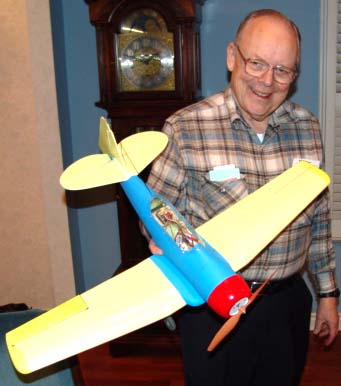 Jack Lemon shared his 9.1 oz. Fan-Tastic Models (www.fan-tasticmodels.com) AT-6. The model features molded extruded polystyrene foam fuselage, wing panels, and stabilizers and high-impact polystyrene vacuformed parts. In Jack's version of the model, power is provided by a GWS IPSD 2 motor geared unit. The battery is a FMA high discharge 700mAh Li-Po pack. Jack designed his own retracts for this little plane. They are fantastic! What a great job of engineering! 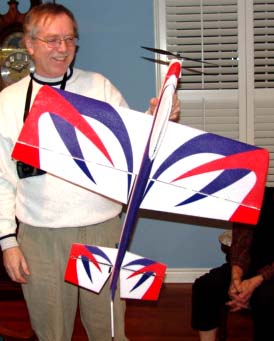 Richard Utkan had his nearly completed Great Planes U-Can-Do 3D Flight-Flex EP ARF (www.towerhobbies.com). It is powered by the stock 280-size motor which is equipped with ball bearings and 5:1 gearbox. He'd only had a couple of hours to work on it, and it was just about finished. It turns out that this was a spur of the moment purchase when he was visiting Ryder's Hobby Shop. It seems pretty "floppy", but is supposed to be a good flyer and being made of FlightFlex Foam, it should be a good 3D trainer, as it is supposed to survive unexpectedly quick landings very well. After the show and tell we watched a video called "Electric Flight in the 90's". Ken Myers and Jeff Hauser produced this video in 1989 using an Apple IIGS for the graphics and two video machines for editing the footage. Footage included models that were tapped from the early-80's through 1989 by the EFO and the EMFSO. Many of the members had never seen these great flying planes before. Ken was able to add a lot of personal comments about the planes and pilots to go along with the music and narration on the video.
A note on the Video: Anyone who is interested in a copy of the video "Electric Flight in the ‘90's, produced in 1989, can get a copy for $10 by contacting Ken Myers. This is NOT a professional video, and the master has lost some of its quality over the past 16 years, but even a copy of it is still very watchable and interesting from an historical perspective. Ken doesn't have the ability to put it on DVD, so VHS tape is the only option at this time. More on Motor Selection
I read the "Its a Conspiracy" article and found his observations interesting. I've been using AXI motors for a year now, and find them to be a lot less trouble than the geared motor that would give the same prop performance.
That is exactly what I've been trying to show here in the Ampeer with several of my articles. A better site for data on AXI motors is www.modelmotors.cz/index.php?id=en&nc=domu That is the English version of the Model Motors site. KM  This is photo of Dick's Extra from his Web site. Here is the data he provided there: Modeltech ARF - Built November 2004, Powered by a AXI 2820/12 Brushless Motor swinging a 10/5E prop on 3S-1P Kokam 2000 Hi capacity Li-Poly Cells. Current is 30 Amps, Weight 47 oz. Update on the Alfa Models Corsair Review
Ken, Since writing to you and giving you my Alfa Models Review of Corsair, I have changed the motor and ESC. The new motor is a Typhoon-micro 6/20, brushless. The ESC is Jeti Advance 18 - 3P. The prop is 8 X 3.8 APC Slo Fly.
Mike Southwood
New Texas Indoor Club
Dear Sir: Could you please add a link to our Indoor Electric club? Tyler Eflight Modelers (TEN) located in Tyler Texas. The web sight is www.ten-spot.com
(I did, but thought that everyone should know about it via the Ampeer. KM) Some Thoughts from Joe Hass
Hi Ken! I have a few thoughts after reading the February AMPEER.
Joe Hass
Thanks Joe for being kind enough to share your mistakes with us so we don't have to learn the hard way! It was also good that you shared this information about the Li-Po fire during Dave Thacker's presentation at your club's March 9 meeting.
Dave Thacker on Li-Po Batteries
Dave Thacker, of Radical RC (www.radicalrc.com), was the guest speaker at the Skymaster's meeting on March 9, 2005. He discussed the characteristics and safe handling of batteries made of Li-Po cells. The following is a summary of his main points. Li-Po cells have created a major advance in electric flight power systems. When batteries made of Li-Po cells are used in a given model, the weight decrease of the power system is enough to bring the performance equal to or exceeding that of a glow system that would be used in a similar size and type model. This is a revolutionary breakthrough.
To keep the Li-Po battery happy, it should not be flown to the cut-off voltage of the ESC. It is best to land when a very well known airframe starts to loose its performance. When a new airframe is fitted with a Li-Po pack, it is best to fly for a short time, land and check the pack voltage to see how much "time" is left in the pack, and continue this procedure until the characteristics of the new pack and airframe are learned. Li-Po cells are safe to use if:
Dave shared his ammo can/field charging box. Dave's ammo box is used to carry his Li-Po chargers, small gel-cell charging battery, charge chords and Li-Po batteries. Dave has installed connectors in the side of his can to plug the charger(s) leads into to feed power into the ammo can. His chargers are Velcro fastened to the outside of the can. He plugs a hydra-head connector lead into the connector inputs inside the can for the charging of the Li-Po batteries. He has a 1/8" hole in the top of the can so that he can know if anything is going "wrong" on the inside while charging.
It was interesting to note that the Skymaster's show and tell at the end of the meeting included 5 or 6 aircraft and only one was gas or glow powered. KM Gasoline Engine versus Electric Motor
For a while now I have been looking for a way to compare a gasoline model airplane engine directly with an electric system. The May 2005 Fly RC magazine allowed me to do just that with back-to-back articles. Andrew Coholic reviewed the Zenoah G26 Gasoline Engine starting on p40 and Russ Pribanic did an electric conversion of the Hobby Lobby Gee Bee on p46. It was almost a head to head comparison of the power systems. Here's the data: Zenoah G26, 16x8 Zinger, 8,220 RPM
While the props are quite different, as well as the atmospheric conditions during the tests, they are close enough for me to say they are providing about the same power for a direct comparison. Weights: Zenoah G26 58.3 oz. w/supplied muffler
AXI 4130/20 14.43 oz.
If you want to have a better flying plane using a 16x8 prop at between 8200 and 8500 RPM, the AXI with Li-Po batteries would save a little over 35 ounces (2.2 lb.) in ready-to-fly weight! Li-Po Cells versus NiMH
The May 2005 issue of Fly RC has a review of the brushless AON T28153000 motor by Tom Hunt on p144. I found it the following quite interesting. 7-cell KAN 950 NiMH 5.7x3e 12.5 amps 91 watts 16,500 RPM
I was aware that a 2S Li-Po pack was much lower in voltage than a 7-cell KAN NiMH pack, but what is interesting here is the difference in the 1P and 2P Kokam packs. Paralleling the 8C 1500mAh packs (12 amp max. continuous current) lets each pack work much more efficiently, as can be seen from the numbers.
10-cell 1950FAUP NiMH 11x7e 22 amps 227 watts 6,700 RPM
It can be clearly seen that the Sanyo 1950mAh NiMH 10-cell pack out performs the paralleled Kokam 1500 8C cells that make up the 3S2P 3000mAh Li-Po pack. The 15C 2000mAh cells that make up the 4000mAh pack perform better than a 10-cell Sanyo NiMH pack, while the 20C cells making up the 3200mAh pack really out perform the Sanyo 10-cell pack.
KAN 950 0.0180 ohms (Motocalc)
If you are having trouble with these numbers, here is an example using the 10-cell Sanyo NiMH pack and Kokam 3 cell 20C pack. A 10-cell Sanyo 1950FAUP pack is said to have 12 volts (1.2v x 10 cells) at a given time near the beginning of the flight and would have an impedance of 0.06 ohms (10 cells x 0.006 ohm). At 25 amps the voltage loss would be 0.06 ohms x 25 amps = 1.5 volts. 12 - 1.5 = 10.5v to the ESC at this particular point in time. The Kokam 3200 3S1P is said to have 3.7v * 3 = 11.1 volts somewhere near the beginning of the flight and an impedance of 0.0225 ohms (0.0075 ohms x 3 cells). At 25 amps the voltage loss would be 0.0225 ohms x 25 amps = 0.5625 volts. 11.1 - 0.5625 = 10.5375v to the ESC.
New Ryan Aircraft Zero
With a Hellcat, Wildcat and Corsair in his stable of great Speed 400 WWII designs, Jim Ryan has decided to add an adversary, the Zero. Here is a little preview of his upcoming Zero. KM I'm burning the midnight oil to try and finish my project. On the 20th (March 20) I started cutting wood on an A6M2 Zero, so I've had to work every spare moment on it. It's now glassed and has the first coat of primer, so I should be able to make it (done by the Toledo show) if there are no major hiccups.
|
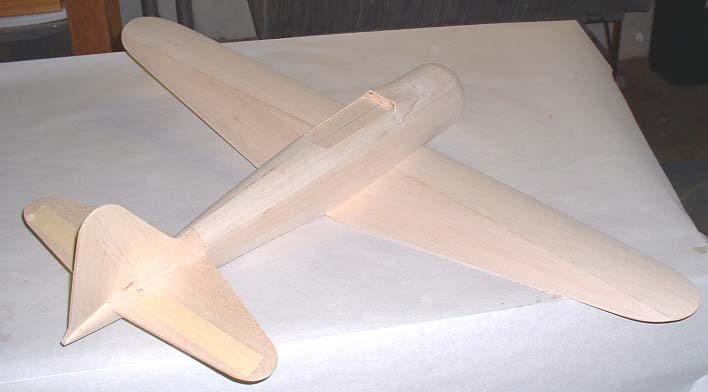
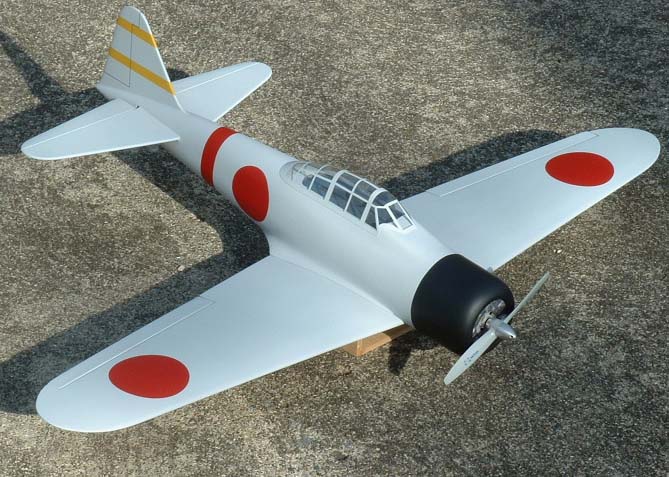
| I'm enclosing a photo of my newly completed A6M2 Zero, which will be featured as a construction article in an upcoming issue of Model Airplane News. The Zero is similar in size and construction to my other Speed 400-size Warbirds: 32" span, 162 SQ IN of wing area and AUW of 18 ounces. The airframe is typical balsa/ply construction, and the wing is foam sheeted with 1/32 balsa. Power is a stock 6V Speed 400 motor on 8 X KAN1050 NiMH cells.
The prototype is finished in the colors of Lt Cdr Shigeru Itaya, who lead the first wave fighter wing in the attack on Pearl Harbor. The covering is .56-ounce fiberglass cloth and finishing epoxy, and I painted the model with an airbrush using Model Master paints. Construction took place over a feverish 11-day period right before the Toledo Expo, and it took an all-nighter to get it completed on time. With its clean airframe the Zero is surprisingly fast on the stock Speed 400 motor, and it does all basic aerobatics (loops, rolls, sustained inverted, etc). The high aspect ratio wing also gives it a low stall speed, so it lands very slowly. After a few more test flights with the stock motor, I plan to try it out with a small brushless system. The construction article and plans will appear in MAN in the next few months, and I plan to release a complete laser cut kit by early 2006. Thanks for a great newsletter, Ken. Jim If you are looking for a Speed 400 Warbird like the Hellcat, Wildcat, Corsair, P-38, Bearcat, P-47 or Reno Racers like the Rare Bear or Super Corsair, be sure to check out Jim's site at http://home.fuse.net/ryan/. These planes really do fly excellently on an inexpensive Speed 400 6v motor and eight cells. They are not Park Flyers! Be sure you have a decent size field to fly them. KM Toledo 2005 & Keith Shaw's Czechmate
The Toledo RC Expo proved to be very interesting this year. I was able to catch up with a lot of flying friends from around the country and have very good chats.
What is Czechmate:
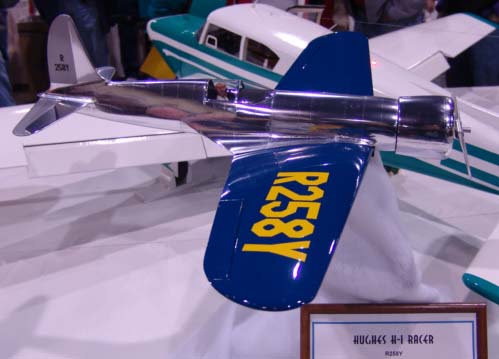
To Reach Ken Myers, you can land mail to the address at the top of the page. My E-mail
address is:
KMyersEFO@aol.com
| |
